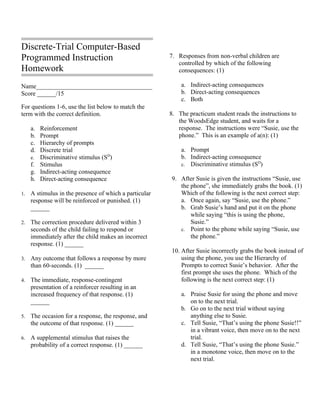Dt workshow homework
- 1. Discrete-Trial Computer-Based Programmed Instruction 7. Responses from non-verbal children are controlled by which of the following Homework consequences: (1) Name_____________________________________ a. Indirect-acting consequences Score ______/15 b. Direct-acting consequences c. Both For questions 1-6, use the list below to match the term with the correct definition. 8. The practicum student reads the instructions to the WoodsEdge student, and waits for a a. Reinforcement response. The instructions were âSusie, use the b. Prompt phone.â This is an example of a(n): (1) c. Hierarchy of prompts d. Discrete trial a. Prompt e. Discriminative stimulus (SD) b. Indirect-acting consequence f. Stimulus c. Discriminative stimulus (SD) g. Indirect-acting consequence h. Direct-acting consequence 9. After Susie is given the instructions âSusie, use the phoneâ, she immediately grabs the book. (1) 1. A stimulus in the presence of which a particular Which of the following is the next correct step: response will be reinforced or punished. (1) a. Once again, say âSusie, use the phone.â ______ b. Grab Susieâs hand and put it on the phone while saying âthis is using the phone, 2. The correction procedure delivered within 3 Susie.â seconds of the child failing to respond or c. Point to the phone while saying âSusie, use immediately after the child makes an incorrect the phone.â response. (1) ______ 10. After Susie incorrectly grabs the book instead of 3. Any outcome that follows a response by more using the phone, you use the Hierarchy of than 60-seconds. (1) ______ Prompts to correct Susieâs behavior. After the first prompt she uses the phone. Which of the 4. The immediate, response-contingent following is the next correct step: (1) presentation of a reinforcer resulting in an increased frequency of that response. (1) a. Praise Susie for using the phone and move ______ on to the next trial. b. Go on to the next trial without saying 5. The occasion for a response, the response, and anything else to Susie. the outcome of that response. (1) ______ c. Tell Susie, âThatâs using the phone Susie!!â in a vibrant voice, then move on to the next 6. A supplemental stimulus that raises the trial. probability of a correct response. (1) ______ d. Tell Susie, âThatâs using the phone Susie.â in a monotone voice, then move on to the next trial.
- 2. 11. After Jenny is given the instructions For the following question, select which discrete âJenny, play with the carâ, she grabs the trial was administered correctly. car and plays with it on the table. #1 Matt states the SD to the child who is facing Which part of the discrete trial is bolded the wall. The child turns away from the wall above? (1) and makes an incorrect response. Matt corrects the incorrect response and continues a. Response with the hierarchy of prompts until the b. Consequence correct response is made. c. Discriminative stimulus (SD) #2 Susie states the SD to her child who is 12. After Johnny is given the instructions looking at her. Her child stops looking at âJohnny, use the phoneâ, he grabs the phone Susie and makes an incorrect response. and puts it up to his head. The practicum Susie corrects the incorrect response and student immediately gives Johnny a piece continues with the hierarchy of prompts of candy. until the correct response is made. Which part of the discrete trial is bolded 14. Which trial was administered correctly? (1) above? (1) a. #1 b. #2 a. Response b. Consequence 15. Why was the other trial incorrect? (1) c. Discriminative stimulus (SD) ______________________________________ ______________________________________ 13. As a child is walking to the playroom, she __ sees a book and says âbookâ. Immediately she receives a piece of candy as reinforcement. Is this a discrete trial? (1) a. Yes b. No

